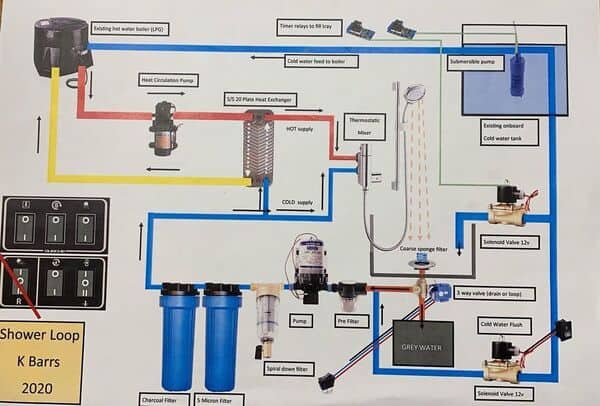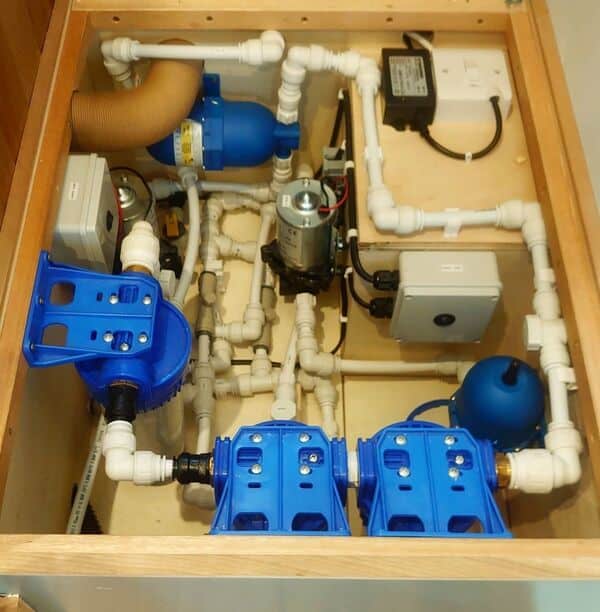Limited water supply is one of the biggest problems for RV or campervan living. People are using quick hacks like navy/military showers to save water. But nothing beats a long hot relaxing shower after a busy day.
A recirculating shower is the only inbuilt option to regain the long hot shower again unless you are dependent on a gym or a truck stop shower.
A recirculating shower is one of the best options to consider if traveling alone. You can decide how much water needs to recirculate, and that’s it. You can extend your boondocking without worrying about the remaining water supply. You can even rely on any water source based on your water filtration setup.
But sometimes, people are reluctant to go for this kind of setup if they live with a partner or family. Let’s explore some of the options down the line. But keep in mind that these recirculating shower builds are evolving day by day. Every day people come up with new affordable design models. You can find plenty of videos on Youtube about these DIY setups.

Table of Contents
Is recirculate shower the same as a showermiser?
Showermiser is another option to save water. Showermiser is circulating unheated hot water back to the fresh tank while you wait for the hot water. But I’m not planning to discuss that option here.
Some turnkey solutions are already available for this option. Some high-end RVs are already equipped with plumbing to support these showermisers.
You may have to DIY your recirculate shower system most of the time. Building from scratch may look like much work. But you can design one that suits your needs best.
The average household, RV water usage most of the time
A typical US residential house uses 11.6 gallons of water for shower per person per day. But when it comes to a class B camper van, an average freshwater tank holds around 20 – 40 gallons. A class A RV contains the most water, about 70 – 110 gallons. A fifth-wheel trailer holds approximately 60 – 80 gallons range. Class C RV will have around 25 – 75 gallons.
So as you can see, you can’t take the typical long shower bath when you live in a camper van or RV. Of course, you don’t need to worry about the water usage if you can hook up to the campground water line.
Usually, camper vans RV dwellers are doing Navy or military showers. Some are entirely dependent on the campground shower and other public facilities. Or wet wipes and sponges.
The main benefit of recirculating showers is to have as much as a long hot shower with minor water usage. That is the ultimate goal. Especially if you are planning to do boondocking, this is a perfect option to consider. You can easily extend the boondocking time without worrying too much about the water. You can get a long relaxing shower at the end of the day after all.
What are the available options?
You have two options when it comes to water recirculating.
- Reuse water again and again until it gets bad.
This option is most suitable if you live alone or with a partner. Usually, water can reuse up to 6 showers if you have a proper filter setup. I would recommend this setup for two people at most. But it is not restricted to two.
- Reuse water per shower and dump.
This option is ideal for a family or even for a couple. Dump the water after each shower without further usage. Water will recirculate during shower time, so you can take a hot water shower as long as you like.
What kind of filters do recirculating showers need?
The filtration system does the main vital task in the recirculating shower. The more filters you have, the better.
Let me quickly give you a summary of what kind of filters you can use. You can decide the number of filters in the system and the microns values in each.
Polypropylene water filter (PP)
PP filters use in the early stage of filtration. Mainly they remove fine particles from the water like rust, silt, and large sediments.
Kinetic Degradation Fluxion (KDF)
KDF filter made with a high-purity copper-zinc formulation. That is suitable for removing water-soluble lead, mercury, nickel, and other dissolved metals. Also effective in controlling the buildup of bacteria, algae, fungi, and scale. It usually comes with KDF 55 & 85 Process Media. KDF 55 filters are mainly used for shower builds.
Ultrafiltration (UF)
Most of the advanced water filtration plants use UF filters. UF has the capability of removing most organic molecules and viruses. If you are concerned about the quality of the reusing water, this is the best option to consider.
Active Carbon (AC)
Active carbon filters are good at removing chlorine, sediment, volatile organic compounds (VOCs). It also helps to remove odor from water.
What components need for recirculating showers?

- A water heater
- Recirculating water holding tank
- A reusable spin down sediment-water filter
- Ultraviolet (UV) water purifier sterilizer filter
- Filter combinations:
- 5 Microns PP filter, 1 Micron, 0.5 Microns KDF filters
- 10 Microns, 5 Microns PP filters, and Active Carbon block filter
- 5 Microns PP filter, KDF filter of your choice, Active Carbon block filter
You can decide which filter combination you want to build. Micron numbers need to change from larger to lower. I recommend going for any three stages or a higher water filtration system. You can get the best result by combining a spin-down sediment filter and the UV light with this setup.
Recirculating shower maintenance
The main issue with this system is the soap scum buildup in the temporary holding tank. The usual advice is to refrain from using chemical soap/shampoo, especially colored ones. It recommends moving to natural soap usage.
You need to clean the recirculating water holding tank every 2-3 months to clean the soap scum.
If you plan to reuse water a couple of times, you need to run the shower for 4-5 minutes after your bath. By doing this, it will prevent unnecessary buildup in the tank.

What are additional requirements to consider for the recirculating shower?
Even though recirculating showers seems to be a sweet deal, you may need to consider these things.
You need to have two water heaters, and pressure pumps to prevent water mixing. So both shower and sink have separate water lines and no cross-contamination.
This setup takes extra spaces as well as some extra money to build. But the best thing is you don’t need a large water heater for the shower. It takes a short time to heat the water at first, but after it will reuse it. It gets hot faster from consecutive cycles since recirculating water is already warm. A heater like a 2.5 gallon Bosch Electric Mini-Tank Water Heater is more than enough for this purpose.
Extra space to store a recirculated shower tank to hold water. Our target is to use less water and have a more extended shower. So a tank that stores 3 – 4 gallons is more than enough.
The duration of the filters is dependent on your shower usage. Typically filters can extend more than three months.
The extra heater and pressure pump will use some extra power. But day by day, the price of solar panels and Li-ion batteries is falling. You can set up an electrical system that supports these additional devices at less cost.
Still, if you think the above setup’s investment is too high, then check this setup called hour shower by Devid from Gone Boondocking. It is a simple design that dunks in the shower tray and reuses water per shower basis.
It depends on a heat exchanger to heat the recirculating water.
Many custom camper van builders are adding recirculating showers to their build. One of the main reasons to settle for a van is mobility. You should have the freedom to go anywhere you want without too much worry about your water storage. If you can sort out the showering problem, then it will relieve major concerns from your shoulder.
So definitely add a recirculating shower to your build, and you will never regret it again.
